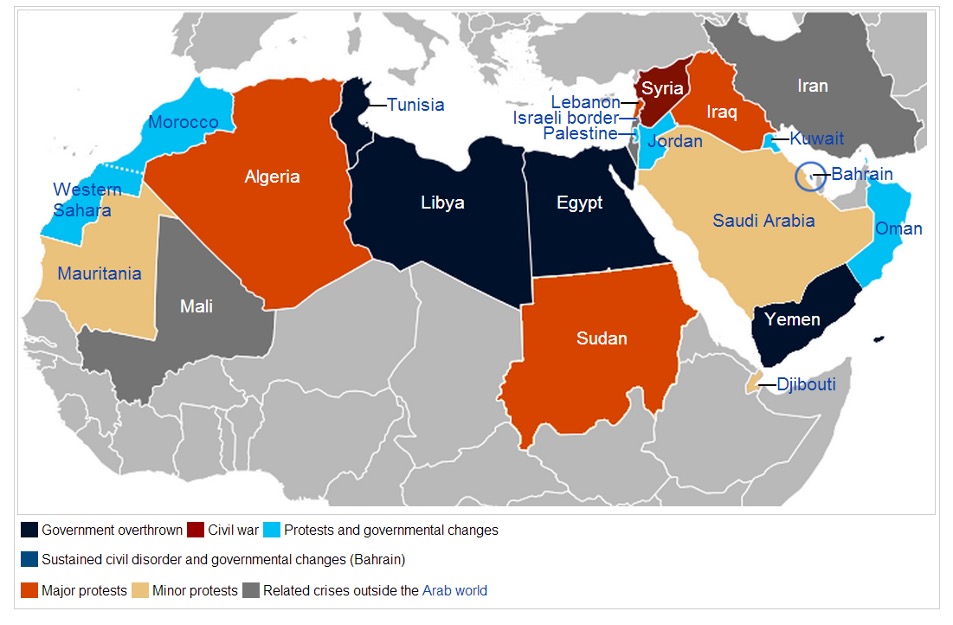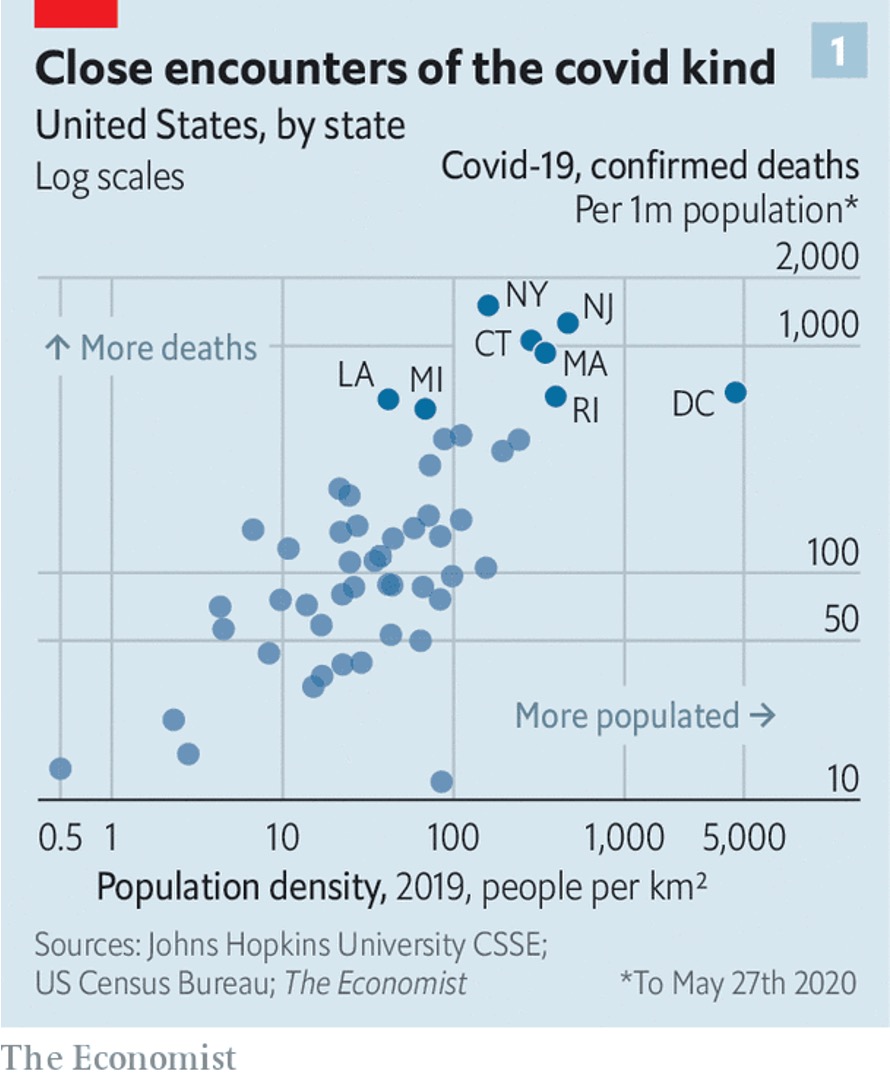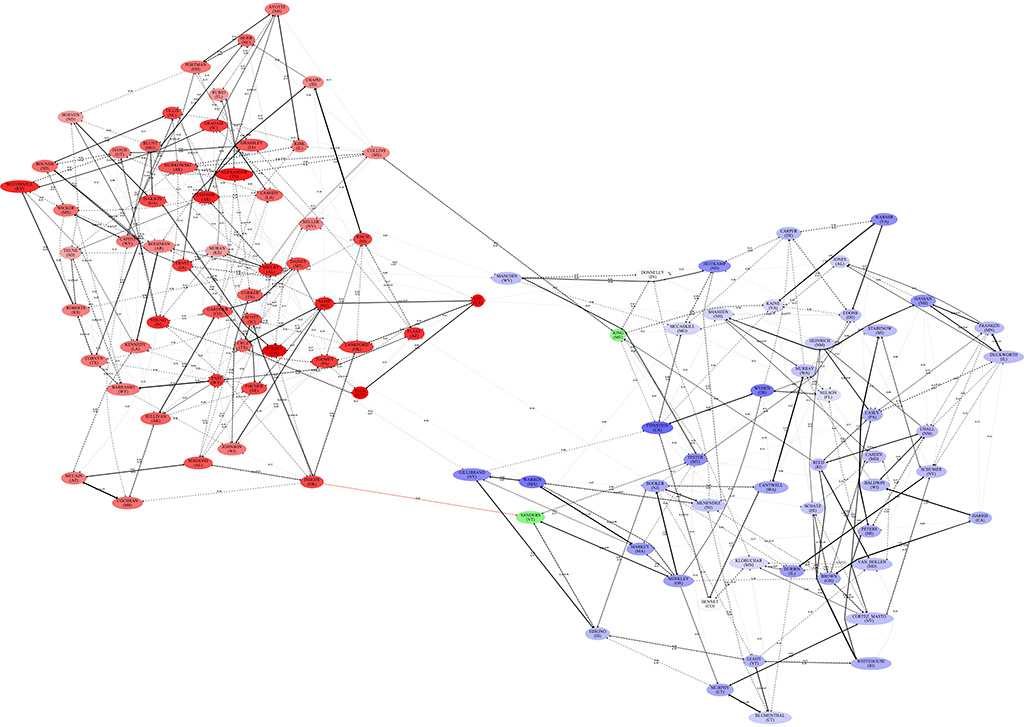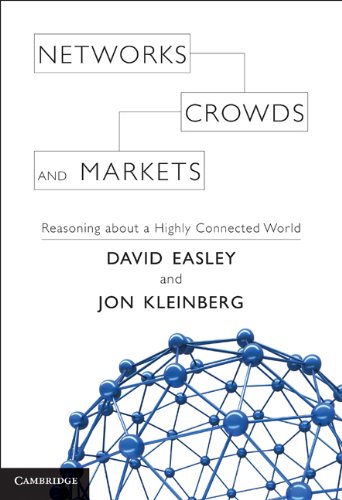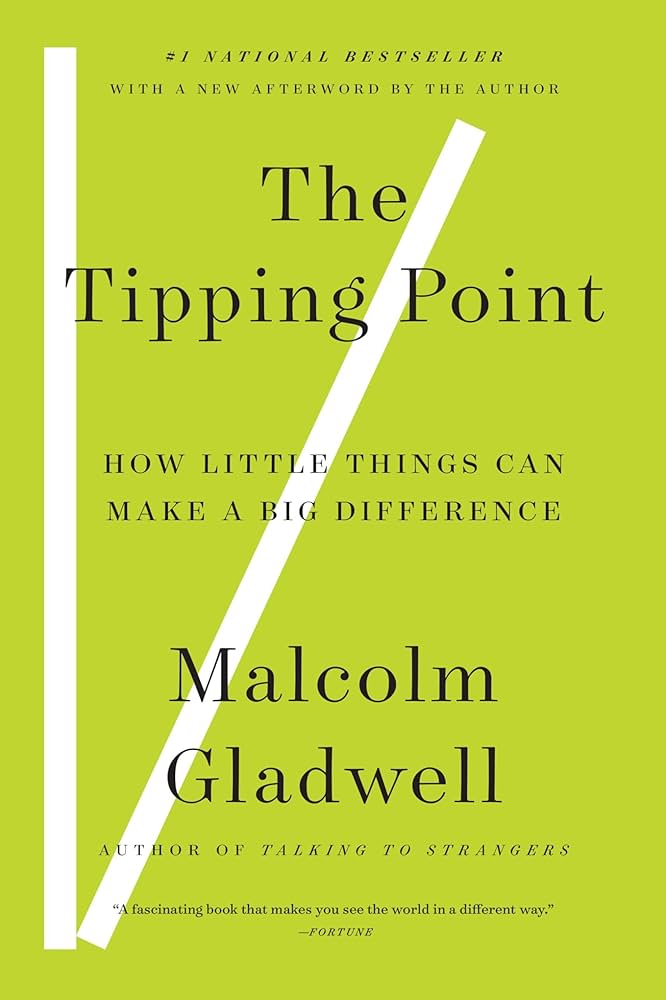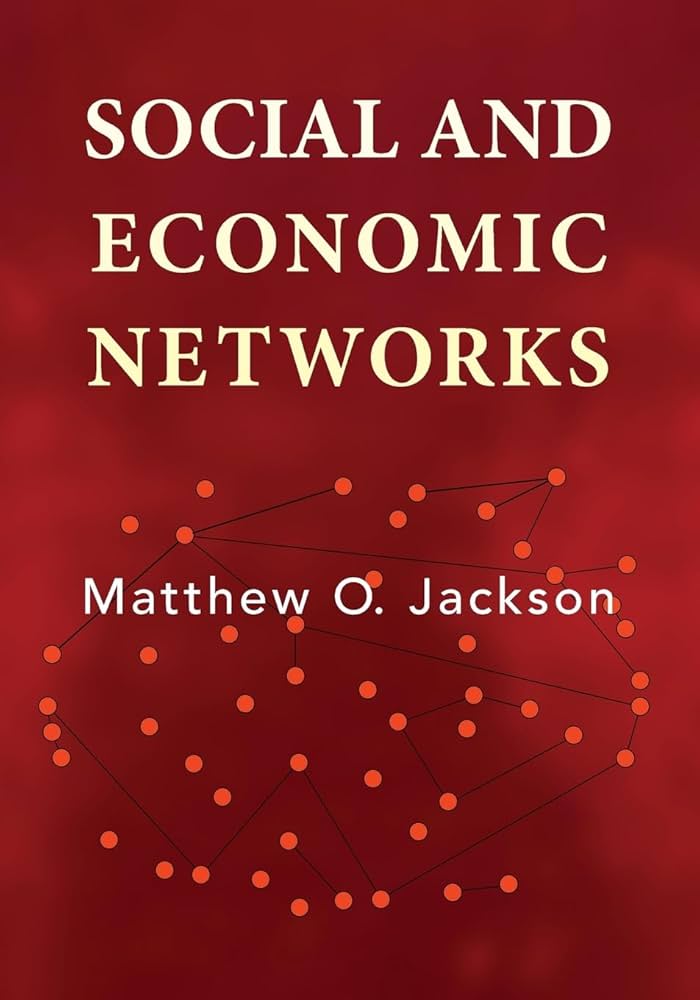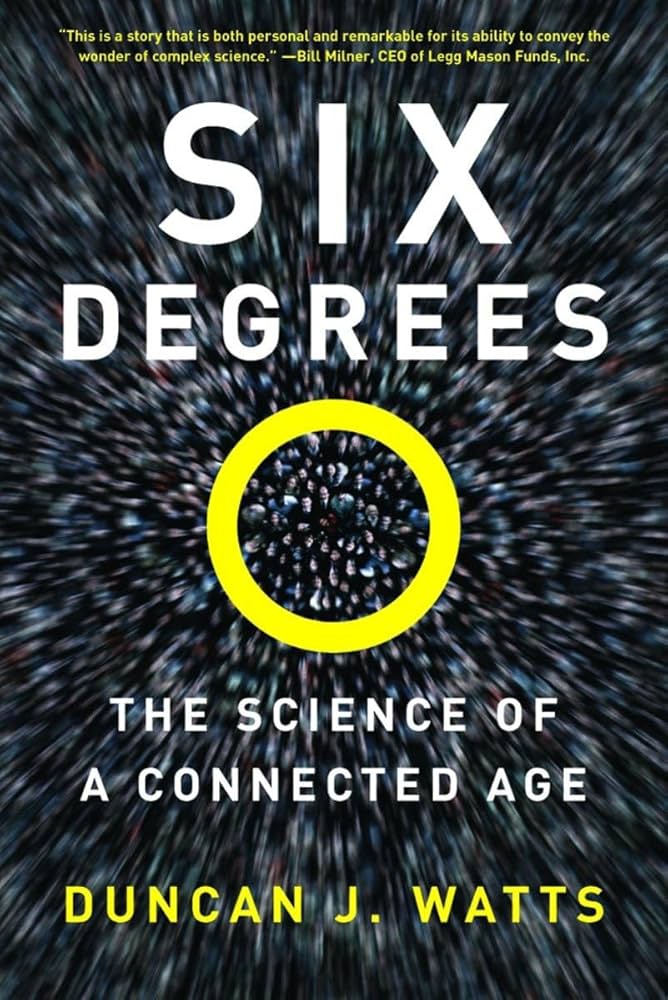|
Course Outline
|
Learning Objectives:
Even after 5 years:
- Know:
- How networks are modeled, how they look like in
the real world , and how they evolve over time
- Basics of social network analysis: Small-world phenomenon, clustering, degree distribution, centrality in networks
- Algorithms like PageRank and web-search auctions running on the Internet
- Be able to do:
- Implement network models using computer programs
- Study the effects of networks, with
examples ranging from contagion to smoking and obesity to online videos going viral: How would the effect vary if the network structure were different?
- Find value in:
- Networks as an essential DCS tool to better understand today's intricately connected world
What type of course is it?
-
This is a lecture-based course.
-
This is not a projects course. Nor is it a discussion course, even
though it will be very much conversational in style.
-
Readings are due after the class, unless otherwise announced.
-
There are some additional notes and video clips that will not be covered in
class. However, you are required to utilize these resources to reinforce
the key concepts.
Textbooks:
[*] Individual chapters from other books (to be provided as hand-outs)
Software:
The following free software will be required. Please install them on your
computer.
[1] Gephi
[2] NetLogo 7
You'll most likely install the Mac OS X Silicon version of NetLogo. After you download the dmg file, double click on it and drag-and-drop the NetLogo folder into your Applications folder.
[3] Visual Studio Code with Python 3
Evaluation:
-
20% Points: One in-class midterm exam
-
15% Points: Final paper
-
40% Points: Summative Assessment (SA): Problem solving and programming
assignments
-
20% Points: Formative Assessment (FA): There will be a series of regular formative assignments (FAs).
-
5% points for good citizenship: Attendance, adherence to the screen policy, and active participation in class, including note taking. Taking handwritten notes is highly recommended for its many benefits.
Students will be asked to report the status of their note taking.
-
Points to letter grade conversion: 94% A, 90%
A-, 85% B+, 80% B, 75% B-, 70% C+, 65% C, 60% C-, 55% D, below 55% F
|
Late Policy:
|
Outline of Topics:
| Week |
Question |
Topics |
Readings |
Additional Notes/Links |
Week 1
(9/3)
|
Course introduction: Why study networks? What's the foundation of the study of networks?
|
|
|
Slides
(Course Intro)
|
Week 2
(9/8, 9/10)
|
What is a network? How can we visualize a network?
|
1. Basics of graph theory
2. Network visualization with Gephi
|
[EK] Ch 2
|
1. Slides
(Basics of graph theory)
2. Slides (Gephi)
3. Dolphins dataset for Gephi
|
Week 3
(9/15, 9/17)
|
How can we analyze a real-world network? What are some common properties of networks?
|
Macro-level social network analysis:
giant component, small-word effect, clustering, degree distribution
|
[EK] Ch 2
[Jack] Ch 2
|
1. Slides (Social Network Analysis)
2. 3.5 degrees of separation in Facebook
3. Power law debate
4. Barabasi's response
5.
Petter Holme's blog post on it
|
Week 4
(9/22, 9/24)
|
How can we analyze a real-world network? (continued)
|
Micro-level social network analysis:
1. centrality
2. Experiments with Gephi
Assignments 1 and 2 (experiments and theory) out
|
[Jack] Ch 2
|
Slides (continued)
|
Week 5
(9/29, 10/1)
|
1. What's the effect of different types of edges?
2. How can we use it to detect communities in a network?
|
1. The strength of weak ties
2. Community detection algorithms
|
[EK] Ch 3
Granovetter's paper
|
1. Slides (The strength of weak
ties)
2. Note on Girvan-Newman algorithm
|
Week 6
(10/6, 10/8)
|
Are the nodes connected to each other kind of the same?
|
Homophily
|
[EK] Ch 4
|
Slides: Homophily
|
| Fall Break |
|
|
|
|
Week 7
(10/15)
|
What can we say about a network having friends as well as enemies?
|
Structural balance: positive and negative relationships
|
[EK] Ch 5
|
Slides: Structural balance
|
Week 8
(10/20, 10/22)
|
Modeling Networks: How can we model network formation in the real world? And why should we model?
|
1. Network Formation:
Random-graph models and their properties
2. Schelling's model of segregation
Midterm exam on 10/20
|
[Jack] Ch 4, 5
[Wat] Ch 3, 4
|
1. Slides (Models of network formation)
2. Prof. Irfan's NetLogo tool to study Erdos-Renyi random graphs
3. Homophily slides above for Schelling's model
|
Week 9
(10/27, 10/29)
|
Modeling Networks (continued)
|
1. Watts-Strogatz and preferential-attachment models
2. NetworkX: network programming in Python
Assignment 3 and 4 (modeling networks: theory and experiments) out
|
|
NetworkX tutorial
by Prof. Irfan
|
Week 10
(11/3, 11/5)
|
What is the effect of a network as a whole on people's behavior? For example, how does a video get viral on a social network? Similarly, how did the Facebook
post "Hi World, we want a puppy!" get over a million likes within a few hours?
|
Cascading behavior/diffusion in networks
|
[EK] Ch 19
|
1. Slides (diffusion)
2. One person starts a dance party
3. Kleinberg's talk
4. Interview of Duncan Watts by Fast Company
|
Week 11
(11/10, 11/12)
|
How does a disease propagate over a network? What is the difference
between the propagation of behavior and the propagation of diseases?
|
1. Diffusion (continued)
2. Epidemics
Assignment 5 (programming: epidemics and cascading behavior) out
|
1. Ch 21 of EK
2. Optional: Ch 10 of Barabasi's Network Science
|
Slides (epidemics)
|
Week 12
(11/17, 11/19)
|
We've talked about structures of networks and the connection between
network structures and various social phenomena. Can we say something about
economic networks where the interactions are primarily strategic?
How can we model such strategic interactions?
|
Game theory
|
[EK] Ch 6
|
1. Slides (Game theory)
2. A Beautiful Mind: How it missed NE
3. Russia-Ukraine war:
4. Trump & game theory:
|
| Thanksgiving Break |
|
|
|
|
Week 13
(12/1, 12/3)
|
How can we model one very common type of strategic interaction that we see
everyday--auctions?
|
Auction
|
[EK] Ch 9
|
Slides
(Auctions)
|
Week 14
(12/8, 12/10)
|
How does Google and other search engines use auction to make money?
|
Sponsored search markets
Assignment 6 (game theory, auction, and sponsored search markets) out
|
[EK] Ch 15
|
1. Slides (Sponsored search markets)
2. Prof. Irfan's video lecture
3. Greg Taylor (Oxford) on the economics of search
engines
|
|
Additional topic (time permitting)
|
Matching: Another example of strategic interactions that received many plaudits due
to its humanitarian cause is the kidney exchange program. What is
the networked economy foundation of such a program?
|
The famous stable marriage problem for two-sided matching
|
Stable marriage handout
|
Slides (Matching)
|
|
Additional topic (time permitting)
|
Let's talk about one special network that we use everyday--the Internet.
What does it look like? How does Google search it?
|
WWW: structure
Link analysis and web search--PageRank
|
[EK] Ch 13, 14
|
1. Slides (Information Networks)
2. Vannevar Bush's Memex
3. Google's Matt Cutts on PageRank
|
|
Collaboration Policy
With some exceptions, summative assignments (SAs) will normally be done individually. In contrast, formative assignments (FAs) will be group work, but you must write your own submission individually.
Students are expected to follow Bowdoin's Academic Honor Code.
Following is the collaboration policy for individual assignments. You are encouraged
to discuss ideas and techniques broadly
with your classmates, but not specifics of assigned problems. Discussions should be
limited to
questions that can be asked and answered without using any
written medium (e.g., pencil and paper, board, or email). This means that at
no time should a student read anything written by another
student. Violation of this policy
is grounds for me to initiate an action that would be filed with the
Dean's office and would come before the Conduct Review Board. If you have any
questions about this policy, PLEASE do not hesitate to contact me.
This will be a zero-tolerance policy.
If in the future you provide your work to other students, this will also
constitute a violation of Bowdoin's honor code.
|
AI Policy
We will follow the DCS AI policy in this course.
What counts as Generative AI?
Generative AI refers to all the AI systems that can create new content like text, code, images, audio, and other types of media. This includes but is not limited to:
- Large language models (ChatGPT, Claude, Gemini, etc.), apps and agents derived from them, and aggregator interfaces (Amplify, LibreChat, etc.)
- Code generation tools (GitHub Copilot, Google Colab, Cursor, etc.)
- Image generators (DALL-E, Midjourney, etc.)
- AI-powered writing assistants and autocomplete features
- NotebookLM, Quizlet AI features, and other AI-enhanced study tools
Always acknowledge what generative AI tools were used to help you complete assignments.
How can generative AI help you to learn in this course?
- Converting slides and notes to study guides and podcasts (e.g., NotebookLM)
- Creating practice materials like flashcards and mock quizzes or exams (e.g., Quizlet)
- Proposing a study plan
- Providing alternative explanations or examples
- Suggesting refinements to grammar and corrections to spelling
- A guide to debugging code
How can generative AI impair your learning in this course?
- For coding projects, AI often misses design layers, making results hard to debug
- Reduces critical thinking and problem-solving abilities
- Can limit creativity
- Creates a sense of false confidence
- Creates dependency
- Reduces retention
- Limits research skills
- Denies you the possibility of self-expression in a constructive environment
Other costs of using AI
- Environmental impact – large energy use
- Labor exploitation – poorly paid workers for moderation and labeling
- Digital colonialism – reinforces inequalities and Western perspectives
- Digital divide – widens gaps in tech access
- Aggregation – concentrated power in few companies
- Privacy – inputs may be stored despite disclaimers
Why do we give you assignments?
"We don’t assign essays because the world needs more student essays." - Emily Bender
Assignments are designed to help you develop essential skills and ways of thinking that will serve you throughout your education and beyond. Each assignment is an opportunity to practice critical thinking, develop your unique voice, learn from struggle, engage with material, demonstrate learning, and prepare for future challenges.
Academic Integrity Expectations
- Be transparent about AI use
- When in doubt, acknowledge it
- Submit your prompts with assignments
- Understand that overreliance hinders learning
- Violations will be treated as academic dishonesty
When is generative AI not allowed?
- To generate code. AI code lacks structure and context and is often too complicated to debug (Prof. Irfan can give you many examples). You must write the initial draft of code yourself.
- To generate text; e.g., to flesh out an outline, leading to an initial draft that you intend to revise
- To brainstorm – your background is richer than AI’s
- To solve problems – designed to strengthen critical thinking
- As a search engine for facts – verify independently
- To analyze data or interpret results without your own reasoning
- To generate ideas for creative projects or research questions
- To complete exams or quizzes unless permitted
- To translate assignments or materials without permission
When can generative AI be used?
- Polishing text by checking for grammar, spelling, and styling suggestions
- Outlining, i.e., preparing an initial structure with AI to be expanded with your own perspective (note that the opposite is not allowed)
- Debugging your code, including generating test cases
- Getting help on a software tool (e.g., how do I do X?)
- Finding resources to support research
- Testing discussion questions for class
- Checking your work and getting preliminary feedback
|
Screen Policy
We will follow the DCS screen policy.
No screen use is permitted in class unless explicitly stated by the instructor or in cases of learning accommodations. This includes phones, tablets, and computers. Most courses will display a symbol during presentations that indicates when screen use is allowed. When screens are not permitted, all devices should be put away and out of sight.
If you have a documented accommodation that allows the use of a laptop or tablet for note-taking, please make sure to submit the appropriate materials to the professor.
|

